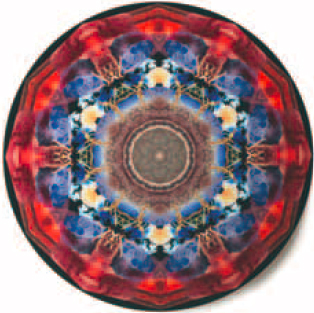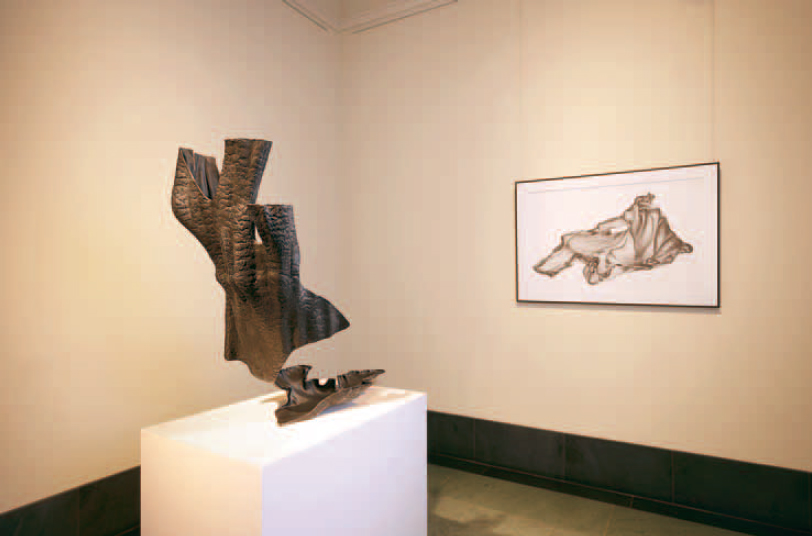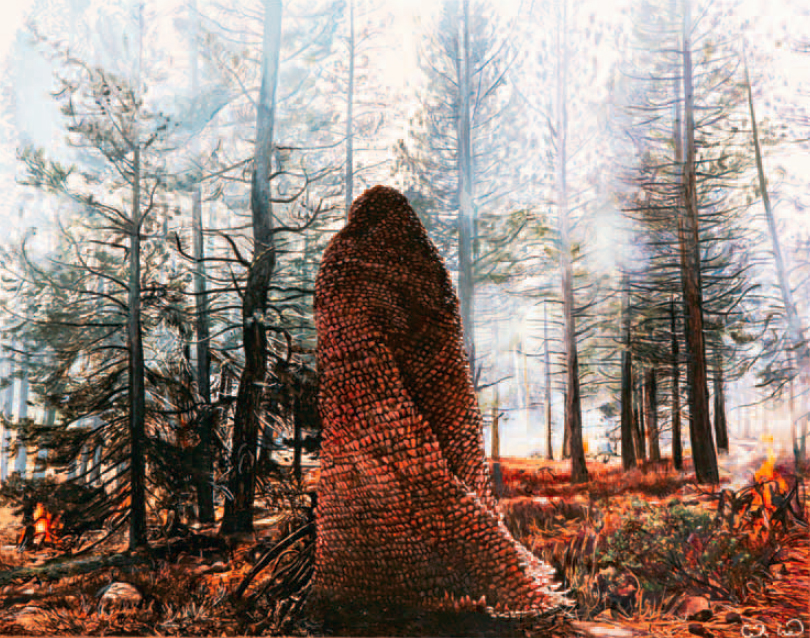Adrien Segal: Data Sculptor
By Juliana Biondo
Assistant Curator, World Bank Group Art Program

Year Without a Summer
From the Wheat Mandala Series, 2018
Digital print on acrylic
40 inch diameter
The exhibit of work by Adrien Segal, Force Majeure: Wildfire and Wheat was on display in the National Academy of Sciences’ West Gallery from February 18 through July 15, 2020.
The scientific process is centered on the elimination of bias in an effort to reveal an objective truth. The artistic process is founded on the celebration of the emotional to showcase the experience of being human on the most personal of levels. One process seeks to strip away subjectivity while the other seeks to delve into its depths. How can these two seemingly opposite worlds cross paths?
In her presentation at the KIKK Festival—a festival promoting cross-disciplinary conversations across art, culture, science, and technology—artist Adrien Segal shared a charming graphic. The image was divided into two columns: the left side spoke about how science can be used to clone a Tyrannosaurus rex, for example, while the right side explained how humanities can be used to tell us why that might not be the best idea. How these two worlds can cross paths is perhaps the wrong question, for these worlds are two sides of the same coin: our understanding of the world in which we live.
Albert Camus (1913–1960), French philosopher, author, and journalist once stated “Art for art sake is not understandable to the masses or else in no way expresses the truth. Art cannot be a monologue.” Bringing this idea to the current day, Brian Eno, an English musician, record producer, visual artist, and theorist, also stated a similar sentiment, “Stop thinking about artworks as objects, and start thinking about them as triggers for experiences.” And yet another world-renowned thinker and maker, Danish-Icelandic artist Olafur Eliasson states, “What does looking actually mean? Why am I seeing things the way I am seeing them? Instead of questioning the object, you are questioning yourself. So, art can offer an opportunity for self-evaluation.” Each one of these reflections hints at a similar concept: art is not fixed. Art is a phenomenon that yields meaning only through an audiences’ interaction—active looking—with it.
Artist Adrien Segal found a comparable phenomenon in the scientific world: data.
Data gains its value by the very fact that it records ephemeral moments, and can be endlessly collected over time. While it might freeze a moment of time in the singular sense, it is not static when taken in the aggregate sense. In the aggregate, data is constantly transformed as it demands context and human analysis to tell a story. What does it take for data to go from total agglomeration to clarified narrative? Segal’s sculptural series, Cedar Fire Progression, visualizes a set of data from the California Department of Forestry Fire and Resource Assessment Program. This dataset is the record for how the Cedar Fire burned from October 25 to December 5, 2003. This fire was the third-largest in California history. Segal utilized three-dimensionality to animate the numbers. She did this by visualizing the time data—from 0 to 114, as the fire burned for 114 hours—along an imaginary y-axis and the total areas of the affected land data along an imaginary x-axis. What results is a

Adrien Segal’s Cedar Fire progression sculpture and drawing. This sculpture embodies the shape of the Cedar Fire as it expanded geographically over the first 114 hours that it burned. This wildfire was part of the “2003 Firestorm” event in San Diego County and, at the time, it was the largest recorded wildfire in California’s history. The fire was intentionally started by a novice hunter who became lost and wanted to signal rescuers. Due to the heat, low humidity, moisture, and high winds, the hunter quickly lost control of the fire. The massive burn area totaled 280,278 acres, destroying 2,820 buildings and causing 15 fatalities, including one firefighter.
gorgeous abstracted sculpture racing upward, as delicate as it is solid. Through the re-presentation of data into a three-dimensional work, Segal allows the viewer to have a physical relationship to the information. The data comes into our space; the narrative it tells is now a part of our personal worlds.
In another one of her works, the Wheat Mandala series, the data Segal used did not exist as a series of charts and numbers, but as a wide-ranging collection of materials such as newspaper clippings, historical records, images, headlines, journal entries, and other piecemeal sources. In the work Year Without a Summer, Segal distills these kinds of informational collages about the volcanic eruption of Mount Tambora of 1815 into a circular kaleidoscopic mandala. Choosing to shape the data into this form was intentional: the mandala is a religious object used to focus one’s attention into a meditative state. In this meditative state, it is thought that a more divinely inspired understanding of the human existence can be achieved. Segal is looking to focus our attention around our own processes of scientific inquiry and learning. How do we sift through nonlinear information? What do we allow to capture our attention? How do we decide to focus our energy when learning about something previously unknown to us? Segal proposes that these questions are worth confronting.
In Segal’s hands, data drives the creation of new artistic forms. These forms stand as testimony to an ever-maturing relationship between information and its tangible visualization. In the end, Segal’s works are in fact triggers. She expertly reveals one narrative just to then make us wonder how many more there really are.

Stacked Geodes, 2016
Digital print
19.5 x 24.5 inches
Multidisciplinary artist Nate Reifke hiked the Sagehen Valley in the Sierra Nevada, selecting rocks to inscribe with tribal designs that he then tucked into the landscape during his participation at the ArtSciConverge residency program at the University of California, Berkeley’s Sagehen Creek Field Station. He created a map of key locations of the installations and it was posted at the Field Station. Searching for the rocks became a collaborative performance between the artist and visitors. In essence, Reifke made a navigational puzzle for his audience that brought people closer to the land. The ArtSciConverge residency program was shaped in part by the findings of a 2014 report from the National Research Council about the social effectiveness of field stations. The report noted that although the stations produced good science, they were nonetheless losing funding because they were not robustly connected to the public.

Pine Cone Cloak at Sagehen, 2019
Acrylic on board
8 x 10 inches
Cedra Wood is an artist who participated in the ArtSciConverge residency program at the University of California, Berkeley’s Sagehen Creek Field Station in the Sierra Nevada. Her practice includes making work about the place where she is an artist-in-residence. She collected pine scales and sewed them together into a large cloak that she wore in the forest while walking among piles of natural debris. She later referenced her photographs to create this painting.




